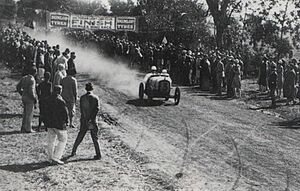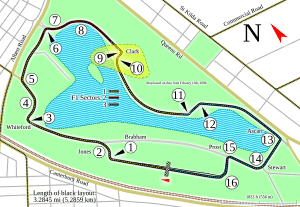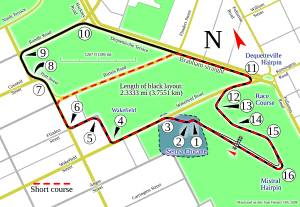Australian Grand Prix facts for kids
| Albert Park Circuit | |
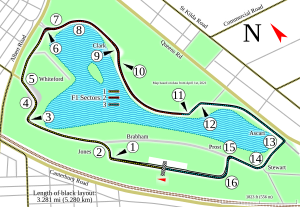 |
|
| Race information | |
|---|---|
| Number of times held | 88 |
| First held | 1928 |
| Most wins (drivers) | |
| Most wins (constructors) | |
| Circuit length | 5.278 km (3.280 mi) |
| Race length | 306.124 km (190.216 mi) |
| Laps | 58 |
| Last race (2025) | |
| Pole position | |
|
|
| Podium | |
|
|
| Fastest lap | |
|
|
The Australian Grand Prix is a super exciting Formula One car race that happens every year in Melbourne, Australia. It's one of the oldest car races in Australia, starting way back in 1928 at a place called Phillip Island.
Since 1985, this race has been a part of the official Formula One World Championship. For a long time, from 1996 onwards, it has been held at the Albert Park Circuit in Melbourne. The only times it didn't happen there were in 2020 and 2021, when the races were cancelled because of the COVID-19 pandemic. Before Melbourne, the race was held in Adelaide.
The Australian Grand Prix is often the very first race of the Formula One season, which makes it extra special! In 2022, it was the third race, but for 2025, it was back to being the season opener.
Contents
History of the Race
Early Days: Before World War II
The Australian Grand Prix officially began in 1928 with a race called the "100 Miles Road Race" at the Phillip Island road circuit. The very first winner was Arthur Waite, driving a special Austin 7 car. For eight years, races were held on this dirt road circuit. Cars made by Bugatti were very strong, winning four times in a row from 1929 to 1932.
After a short break, the race moved to a brand-new track in 1938: Mount Panorama near Bathurst. This track would become very famous! An English driver named Peter Whitehead won that race in a super-fast ERA car. One more race happened in 1939 at Lobethal Circuit before World War II stopped everything.
After the War: New Cars and Tracks
Racing Returns
After World War II, car racing slowly started again. The Grand Prix moved around to different places, like old airfields and street circuits. In 1952, Doug Whiteford won in a new Talbot-Lago Formula One car. This showed that faster, more advanced cars were coming to Australia.
Lex Davison won his first of four Grand Prix titles in 1954. The year before, in 1953, cars raced for the first time around the streets near Albert Park Lake in Melbourne. This same area, much changed, is where the modern Formula One race is held today!
In 1955, Jack Brabham won his first Grand Prix in a Cooper T40. This was important because it was the first time a car with its engine at the back won the race. This design would become very popular later on.
The Tasman Series Era
The Australian Grand Prix became a big part of the Tasman Series from 1963 to 1969. This was a special racing series held in Australia and New Zealand during the European winter. Top Formula One drivers and teams, like Jim Clark, John Surtees, and Jackie Stewart, came to race against local heroes like Jack Brabham and Bruce McLaren. It was a golden age for racing in the region!
Jack Brabham, who even built his own cars, won the Grand Prix three times during this period. Bruce McLaren won twice, and Jim Clark won twice, with his last big victory being at the 1968 Australian Grand Prix at Sandown Raceway.
Formula 5000 Cars
After the Tasman Series, the Australian Grand Prix featured powerful Formula 5000 cars in the 1970s. Drivers like Frank Matich and Graham McRae became stars. Interestingly, in 1976, John Goss became the only driver to win both the Grand Prix and the famous Bathurst 1000 touring car race.
Calder Park Races
In the early 1980s, the Grand Prix moved to Calder Park Raceway. In 1980, Australian Alan Jones, who had just become the Formula One World Champion, won easily in his Williams car. For the next few years, Brazilian driver Roberto Moreno was the one to beat, winning three times. Future four-time World Champion Alain Prost also won a race here in 1982.
Formula One World Championship Era
Adelaide: 1985–1995
The Australian Grand Prix officially joined the Formula One World Championship in 1985. It was held on a challenging street circuit in Adelaide and was always the final race of the season. Drivers and fans loved the exciting atmosphere.
The first F1 race in Adelaide in 1985 was won by Keke Rosberg. It was a tough race in very hot weather. Famous driver Niki Lauda raced for the last time at this event.
The 1986 race was a nail-biter, with three drivers fighting for the championship. Alain Prost won the race and the championship after Nigel Mansell had a dramatic tire blowout.
In 1989, the race was hit by heavy rain. Many drivers didn't want to start because it was so wet. Thierry Boutsen eventually won the race, which was stopped early due to the conditions.
The 1990 race was the 500th Formula One World Championship Grand Prix! It was a thrilling battle between Nelson Piquet and Nigel Mansell, with Piquet winning.
The 1991 race was the shortest F1 race ever, stopped after only 14 laps because of extreme rain. Ayrton Senna was declared the winner.
In 1993, Senna won his 41st and final F1 race, and it was also Alain Prost's last race. They shared a special moment on the podium, showing respect despite their past rivalry.
The 1994 race was famous for a championship-deciding crash between Michael Schumacher and Damon Hill. Schumacher won the championship after both drivers retired from the race. Nigel Mansell, who had returned to F1, won the race.
The final F1 race in Adelaide in 1995 saw a serious crash involving Mika Häkkinen. He was badly hurt but thankfully recovered and raced again. Damon Hill won that last Adelaide race.
Melbourne: 1996–2019, 2022–present
In 1996, the Australian Grand Prix moved to a new home at the Albert Park Circuit in Melbourne. This decision was a bit controversial, with some people protesting because it used a public park. However, the race organizers said it brought many benefits to the state.
The Albert Park track is known for being fast and smooth. It's a temporary circuit, meaning it uses public roads and a car park within the park.
The first race in Melbourne in 1996 had a huge crowd of over 400,000 people! It also started with a big crash involving Martin Brundle, which got a lot of attention. Damon Hill won that first Melbourne race.
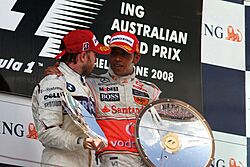
McLaren won in 1997 with David Coulthard, ending a long winless streak. In 1998, McLaren dominated, with Mika Häkkinen and Coulthard finishing far ahead of everyone else. Ferrari got their first Melbourne win in 1999 with Eddie Irvine.
Michael Schumacher then won three races in a row for Ferrari from 2000 to 2002. The 2001 race had a sad moment when a volunteer marshal was killed after a crash. The 2002 race saw a huge crash at the start, taking out many cars. But it was also special because Australian driver Mark Webber finished fifth in his very first F1 race, which was a big achievement for his small team.
Giancarlo Fisichella won for Renault in 2005. In 2006, Fernando Alonso took his first Australian win in a race with many safety car periods. In 2007, Kimi Räikkönen won his first race for Ferrari, and rookie Lewis Hamilton finished on the podium in his F1 debut. Hamilton then won the 2008 race.
Jenson Button won the 2009 race for the new Brawn GP team, which was an amazing story as they had just taken over from Honda. Button also won in 2010 and 2012. Sebastian Vettel won in 2011 for Red Bull.
In 2014, with new hybrid engines, Nico Rosberg dominated for Mercedes. He also won in 2016. Hamilton won for Mercedes in 2015.
The 2020 and 2021 races were cancelled due to the COVID-19 pandemic. The Grand Prix returned in 2022. The track had some big changes to make it faster and encourage more overtaking. Charles Leclerc of Ferrari had a perfect race in 2022, winning from pole position, leading every lap, and setting the fastest lap. This race also set a new attendance record for Melbourne, with over 419,000 people attending.
The 2023 race saw Max Verstappen win his first Australian Grand Prix. It was a very chaotic race with three red flags, which is a Formula One record! The attendance record was broken again, with over 444,000 people.
The 2024 Australian Grand Prix, won by Carlos Sainz Jr., broke attendance records once more, with 452,055 spectators. The 2025 race was won by Lando Norris, who was chased closely by Max Verstappen. George Russell finished third. This race set another new attendance record for the circuit, with 465,498 spectators.
Race Calendar Changes
When the Australian Grand Prix moved to Melbourne, it also changed its spot on the Formula One calendar. In Adelaide, it was always the last race of the season. But in Melbourne, it has usually been the very first race of the year. This means many drivers have made their F1 debut in Melbourne, including champions like Jacques Villeneuve (1996), Lewis Hamilton (2007), Max Verstappen (2015), Fernando Alonso (2001), and Kimi Räikkönen (2001).
To celebrate 10 years of the race in Albert Park in 2005, Australian F1 driver Mark Webber drove his F1 car over the Sydney Harbour Bridge!
Economic Impact of the Race
The Australian Grand Prix brings a lot of discussion about its economic impact. Supporters say it boosts tourism, creates jobs, and brings millions of dollars to Victoria. Opponents argue that it costs taxpayers a lot of money and causes disruptions.
Recent reports show that the Grand Prix does bring significant money into the state. For example, the 2022 race brought an estimated $92 million in direct spending and boosted Victoria's economy by about $171 million. The 2023 race contributed even more, an estimated $268 million, including $144 million in direct spending and creating over 1,100 full-time jobs.
However, other reports have suggested that the costs of hosting the event sometimes outweigh the benefits for taxpayers. This is a topic that continues to be debated.
Spectator Attendance
The number of people who come to watch the Australian Grand Prix has been very high, especially since it moved to Melbourne. The attendance peaked in 2025 with 465,498 spectators over the weekend.
The Australian Grand Prix Corporation doesn't always release exact crowd figures, citing security reasons. However, official numbers are released, and they show how popular the event is.
Here are some attendance figures since 1995:
- 1995 (Adelaide) – 520,000 (210,000 on race day)
- 1996 (Melbourne) – 401,000 (150,000 on race day)
- 1997 – 289,000
- 2004 – 360,885 (121,500 on race day)
- 2005 – 359,000 (103,000 on race day)
- 2006 – 301,800
- 2007 – 301,000 (105,000 on race day)
- 2008 – 303,000 (108,000 on race day)
- 2009 – 286,900
- 2010 – 305,000 (108,500 on race day)
- 2011 – 298,000 (111,000 on race day)
- 2012 – 313,700 (114,900 on race day)
- 2013 – 323,000 (103,000 on race day)
- 2014 – 314,900 (100,500 on race day)
- 2015 – 296,600 (101,000 on race day)
- 2016 – 272,300 (90,200 on race day)
- 2017 – 296,600
- 2018 – 295,000
- 2019 – 324,000 (100,000 on race day)
- 2022 – 419,114 (128,294 on race day)
- 2023 – 444,631 (131,124 on race day)
- 2024 – 452,055 (132,106 on race day)
- 2025 – 465,498 (131,547 on race day)
Who Has Won the Most?
Drivers with Multiple Wins
Drivers in bold are racing in Formula One right now. A pink background means the race was not part of the Formula One World Championship.
Alain Prost is the only driver to win the race in both the older, local formats and as part of the Formula One World Championship.
Australian driver Lex Davison and German driver Michael Schumacher have won the Australian Grand Prix four times each, making them the most successful drivers in its long history. Ferrari is the most successful team, with fourteen wins!
| Wins | Driver | Years won |
|---|---|---|
| 4 | 1954, 1957, 1958, 1961 | |
| 2000, 2001, 2002, 2004 | ||
| 3 | 1930, 1932, 1933 | |
| 1950, 1952, 1953 | ||
| 1955, 1963, 1964 | ||
| 1972, 1973, 1978 | ||
| 1981, 1983, 1984 | ||
| 1982, 1986, 1988 | ||
| 2009, 2010, 2012 | ||
| 2011, 2017, 2018 | ||
| 2 | 1935, 1937 | |
| 1962, 1965 | ||
| 1970, 1971 | ||
| 1974, 1975 | ||
| 1987, 1992 | ||
| 1991, 1993 | ||
| 1995, 1996 | ||
| 1997, 2003 | ||
| 2007, 2013 | ||
| 2008, 2015 | ||
| 2014, 2016 | ||
| Sources: | ||
Winning Teams (Constructors)
Teams in bold are racing in Formula One right now. A pink background means the race was not part of the Formula One World Championship.
| Wins | Constructor | Years won |
|---|---|---|
| 14 | 1957, 1958, 1969, 1987, 1999, 2000, 2001, 2002, 2004, 2007, 2017, 2018, 2022, 2024 | |
| 13 | 1970, 1986, 1988, 1991, 1992, 1993, 1997, 1998, 2003, 2008, 2010, 2012, 2025 | |
| 6 | 1980, 1985, 1989, 1994, 1995, 1996 | |
| 5 | 1955, 1960, 1961, 1962, 1965 | |
| 4 | 1929, 1930, 1931, 1932 | |
| 1935, 1937, 1939, 1947 | ||
| 1974, 1975, 1977, 1979 | ||
| 1981, 1982, 1983, 1984 | ||
| 2014, 2015, 2016, 2019 | ||
| 2 | 1952, 1953 | |
| 1956, 1959 | ||
| 1963, 1964 | ||
| 1966, 1967 | ||
| 1971, 1976 | ||
| 1973, 1978 | ||
| 2005, 2006 | ||
| 2011, 2023 | ||
| Sources: | ||
Winning Engine Manufacturers
Manufacturers in bold are competing in Formula One right now. A pink background means the race was not part of the Formula One World Championship.
| Wins | Manufacturer | Years won |
|---|---|---|
| 14 | 1957, 1958, 1969, 1987, 1999, 2000, 2001, 2002, 2004, 2007, 2017, 2018, 2022, 2024 | |
| 12 | 1997, 1998, 2003, 2008, 2009, 2010, 2012, 2014, 2015, 2016, 2019, 2025 | |
| 10 | 1950, 1951, 1968, 1980, 1981, 1982, 1983, 1984, 1990, 1993 | |
| 8 | 1989, 1994, 1995, 1996, 2005, 2006, 2011, 2013 | |
| 7 | 1972, 1973, 1974, 1975, 1977, 1978, 1979 | |
| 5 | 1961, 1962, 1963, 1964 1965 | |
| 4 | 1929, 1930, 1931, 1932 | |
| 1935, 1937, 1939, 1947 | ||
| 1985, 1988, 1991, 1992 | ||
| 3 | 1956, 1959, 1960 | |
| 1970, 1971, 1976 | ||
| 2 | 1952, 1953 | |
| 1966, 1967 | ||
| Sources: | ||
* Between 1997 and 2003 built by Ilmor
** Between 1968 and 1993 designed and built by Cosworth, funded by Ford
Winners by Year
A pink background means the race was not part of the Formula One World Championship.
- * From 1932 to 1948, the winner was chosen based on a handicap system.
- + The 1937 race was called the "South Australian Centenary Grand Prix" and happened on December 26, 1936.
- # The 1928 race was officially known as the "100 Miles Road Race".
| Year | Driver | Constructor | Location | Report |
|---|---|---|---|---|
| 1928 # | Austin | Phillip Island | Report | |
| 1929 | Bugatti | Report | ||
| 1930 | Bugatti | Report | ||
| 1931 | Bugatti | Report | ||
| 1932 | Bugatti | Report | ||
| 1933 | Riley | Report | ||
| 1934 | Singer | Report | ||
| 1935 | MG | Report | ||
| 1936 | Not held | |||
| 1937 + | MG | Victor Harbor | Report | |
| 1938 | ERA | Bathurst | Report | |
| 1939 | MG | Lobethal | Report | |
| 1940 – 1946 |
Not held due to World War II | |||
| 1947 | MG | Bathurst | Report | |
| 1948 | BMW | Point Cook | Report | |
| 1949 | Delahaye | Leyburn | Report | |
| 1950 | Ford | Nuriootpa | Report | |
| 1951 | GRS-Ford | Narrogin | Report | |
| 1952 | Talbot-Lago | Bathurst | Report | |
| 1953 | Talbot-Lago | Albert Park | Report | |
| 1954 | HWM-Jaguar | Southport | Report | |
| 1955 | Cooper-Bristol | Port Wakefield | Report | |
| 1956 | Maserati | Albert Park | Report | |
| 1957 | Ferrari | Caversham | Report | |
| 1958 | Ferrari | Bathurst | Report | |
| 1959 | Maserati | Longford | Report | |
| 1960 | Cooper-Maserati | Lowood | Report | |
| 1961 | Cooper-Climax | Mallala | Report | |
| 1962 | Cooper-Climax | Caversham | Report | |
| 1963 | Brabham-Climax | Warwick Farm | Report | |
| 1964 | Brabham-Climax | Sandown | Report | |
| 1965 | Cooper-Climax | Longford | Report | |
| 1966 | BRM | Lakeside | Report | |
| 1967 | BRM | Warwick Farm | Report | |
| 1968 | Lotus-Cosworth | Sandown | Report | |
| 1969 | Ferrari | Lakeside | Report | |
| 1970 | McLaren-Repco/Holden | Warwick Farm | Report | |
| 1971 | Matich-Repco/Holden | Report | ||
| 1972 | Leda-Chevrolet | Sandown | Report | |
| 1973 | McRae-Chevrolet | Report | ||
| 1974 | Lola-Chevrolet | Oran Park | Report | |
| 1975 | Lola-Chevrolet | Surfers Paradise | Report | |
| 1976 | Matich-Repco/Holden | Sandown | Report | |
| 1977 | Lola-Chevrolet | Oran Park | Report | |
| 1978 | McRae-Chevrolet | Sandown | Report | |
| 1979 | Lola-Chevrolet | Wanneroo | Report | |
| 1980 | Williams-Cosworth | Calder | Report | |
| 1981 | Ralt-Ford | Report | ||
| 1982 | Ralt-Ford | Report | ||
| 1983 | Ralt-Ford | Report | ||
| 1984 | Ralt-Ford | Report | ||
| 1985 | Williams-Honda | Adelaide | Report | |
| 1986 | McLaren-TAG | Report | ||
| 1987 | Ferrari | Report | ||
| 1988 | McLaren-Honda | Report | ||
| 1989 | Williams-Renault | Report | ||
| 1990 | Benetton-Ford | Report | ||
| 1991 | McLaren-Honda | Report | ||
| 1992 | McLaren-Honda | Report | ||
| 1993 | McLaren-Ford | Report | ||
| 1994 | Williams-Renault | Report | ||
| 1995 | Williams-Renault | Report | ||
| 1996 | Williams-Renault | Albert Park | Report | |
| 1997 | McLaren-Mercedes | Report | ||
| 1998 | McLaren-Mercedes | Report | ||
| 1999 | Ferrari | Report | ||
| 2000 | Ferrari | Report | ||
| 2001 | Ferrari | Report | ||
| 2002 | Ferrari | Report | ||
| 2003 | McLaren-Mercedes | Report | ||
| 2004 | Ferrari | Report | ||
| 2005 | Renault | Report | ||
| 2006 | Renault | Report | ||
| 2007 | Ferrari | Report | ||
| 2008 | McLaren-Mercedes | Report | ||
| 2009 | Brawn-Mercedes | Report | ||
| 2010 | McLaren-Mercedes | Report | ||
| 2011 | Red Bull-Renault | Report | ||
| 2012 | McLaren-Mercedes | Report | ||
| 2013 | Lotus-Renault | Report | ||
| 2014 | Mercedes | Report | ||
| 2015 | Mercedes | Report | ||
| 2016 | Mercedes | Report | ||
| 2017 | Ferrari | Report | ||
| 2018 | Ferrari | Report | ||
| 2019 | Mercedes | Report | ||
| 2020 | Cancelled due to COVID-19 pandemic | Report | ||
| 2021 | Not held due to COVID-19 pandemic | |||
| 2022 | Ferrari | Albert Park | Report | |
| 2023 | Red Bull-Honda RBPT | Report | ||
| 2024 | Ferrari | Report | ||
| 2025 | McLaren-Mercedes | Report | ||
| Sources: | ||||
See also
 In Spanish: Gran Premio de Australia para niños
In Spanish: Gran Premio de Australia para niños
- Motorsport in Australia
- Albert Park Circuit
- List of Australian motor racing series


